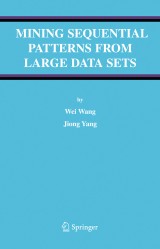Details

Mining Sequential Patterns from Large Data Sets
Advances in Database Systems, Band 28
|
96,29 € |
|
| Verlag: | Springer |
| Format: | |
| Veröffentl.: | 26.07.2005 |
| ISBN/EAN: | 9780387242477 |
| Sprache: | englisch |
| Anzahl Seiten: | 164 |
Dieses eBook enthält ein Wasserzeichen.
Beschreibungen
In many applications, e.g., bioinformatics, web access traces, system u- lization logs, etc., the data is naturally in the form of sequences. It has been of great interests to analyze the sequential data to find their inherent char- teristics. The sequential pattern is one of the most widely studied models to capture such characteristics. Examples of sequential patterns include but are not limited to protein sequence motifs and web page navigation traces. In this book, we focus on sequential pattern mining. To meet different needs of various applications, several models of sequential patterns have been proposed. We do not only study the mathematical definitions and application domains of these models, but also the algorithms on how to effectively and efficiently find these patterns. The objective of this book is to provide computer scientists and domain - perts such as life scientists with a set of tools in analyzing and understanding the nature of various sequences by : (1) identifying the specific model(s) of - quential patterns that are most suitable, and (2) providing an efficient algorithm for mining these patterns. Chapter 1 INTRODUCTION Data Mining is the process of extracting implicit knowledge and discovery of interesting characteristics and patterns that are not explicitly represented in the databases. The techniques can play an important role in understanding data and in capturing intrinsic relationships among data instances. Data mining has been an active research area in the past decade and has been proved to be very useful.
Related Work.- Periodic Patterns.- Statistically Significant Patterns.- Approximate Patterns.- Conclusion Remark.
<EM>
<P>The focus of Mining Sequential Patterns from Large Data Sets</EM> is on sequential pattern mining. In many applications, such as bioinformatics, web access traces, system utilization logs, etc., the data is naturally in the form of sequences. This information has been of great interest for analyzing the sequential data to find its inherent characteristics. Examples of sequential patterns include but are not limited to protein sequence motifs and web page navigation traces.</P>
<P>To meet the different needs of various applications, several models of sequential patterns have been proposed. This volume not only studies the mathematical definitions and application domains of these models, but also the algorithms on how to effectively and efficiently find these patterns. </P><EM>
<P>Mining Sequential Patterns from Large Data Sets </EM>provides a set of tools for analyzing and understanding the nature of various sequences by identifying the specific model(s) of sequential patterns that are most suitable. This book provides an efficient algorithm for mining these patterns.</P><EM>
<P>Mining Sequential Patterns from Large Data Sets </EM>is designed for a professional audience of researchers and practitioners in industry and also suitable for graduate-level students in computer science. </P>
<P>The focus of Mining Sequential Patterns from Large Data Sets</EM> is on sequential pattern mining. In many applications, such as bioinformatics, web access traces, system utilization logs, etc., the data is naturally in the form of sequences. This information has been of great interest for analyzing the sequential data to find its inherent characteristics. Examples of sequential patterns include but are not limited to protein sequence motifs and web page navigation traces.</P>
<P>To meet the different needs of various applications, several models of sequential patterns have been proposed. This volume not only studies the mathematical definitions and application domains of these models, but also the algorithms on how to effectively and efficiently find these patterns. </P><EM>
<P>Mining Sequential Patterns from Large Data Sets </EM>provides a set of tools for analyzing and understanding the nature of various sequences by identifying the specific model(s) of sequential patterns that are most suitable. This book provides an efficient algorithm for mining these patterns.</P><EM>
<P>Mining Sequential Patterns from Large Data Sets </EM>is designed for a professional audience of researchers and practitioners in industry and also suitable for graduate-level students in computer science. </P>
Contains unique multiple models for various sequential patterns and detailed algorithms on how to mine these patterns. Bio-informaticians not yet familiar with data mining models and algorithms will appreciate the various descriptions of models and algorithms Includes supplementary material: sn.pub/extras
<P>In many applications, such as bioinformatics, web access traces, and system utilization logs, the data is naturally in the form of sequences. Examples of sequential patterns include but are not limited to protein sequence motifs and web page navigation traces. To meet the different needs of various applications, several models of sequential patterns have been proposed. This volume not only studies the mathematical definitions and application domains of these models, but also the algorithms on how to effectively and efficiently find these patterns. It provides a set of tools for analyzing and understanding the nature of various sequences by identifying the specific model(s) of sequential patterns that are most suitable. </P>

















